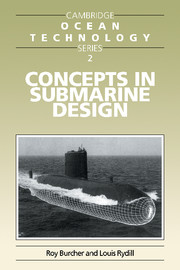Book contents
- Frontmatter
- Contents
- Introduction
- Acknowledgements
- 1 Design in general
- 2 Milestones in submarine history
- 3 Submarine hydrostatics
- 4 The weight/space relationship
- 5 Submarine structures
- 6 Powering of submarines
- 7 Geometric form and arrangements
- 8 Dynamics and control
- 9 Submarine systems
- 10 Considerations of building and costs in design
- 11 Generating a concept design
- Appendix 1 Hydrostatic conditions of flotation
- Appendix 2 Operational practice for keeping in trim
- Appendix 3 Assessing weight and size of variable ballast
- Appendix 4 Submarine pressure hull strength (Prediction of interframe collapse pressures)
- Appendix 5 Estimates of resistance and propulsion
- References and suggested reading
- Index
8 - Dynamics and control
Published online by Cambridge University Press: 05 July 2014
- Frontmatter
- Contents
- Introduction
- Acknowledgements
- 1 Design in general
- 2 Milestones in submarine history
- 3 Submarine hydrostatics
- 4 The weight/space relationship
- 5 Submarine structures
- 6 Powering of submarines
- 7 Geometric form and arrangements
- 8 Dynamics and control
- 9 Submarine systems
- 10 Considerations of building and costs in design
- 11 Generating a concept design
- Appendix 1 Hydrostatic conditions of flotation
- Appendix 2 Operational practice for keeping in trim
- Appendix 3 Assessing weight and size of variable ballast
- Appendix 4 Submarine pressure hull strength (Prediction of interframe collapse pressures)
- Appendix 5 Estimates of resistance and propulsion
- References and suggested reading
- Index
Summary
INTRODUCTION
8.1 Historically, it was not until the advent of the nuclear submarine with its capability for sustained high speed that the focus of attention of the submarine designer moved from the provision of adequate means for control of motion in the vertical plane – particularly at periscope depth – to achievement also of an appropriate balance between manoeuvrability and dynamic stability, with the emphasis again on motion in the vertical plane. Concentration of attention on depth changing and keeping rather than on course changing and keeping was natural because of the inherent risks in the high speed submarine – even with better diving depth capability through increased pressure hull strength – of accidentally exceeding the allowed maximum depth, a hazard regarded as potentially more dangerous than inadvertent surfacing.
As can be appreciated, there are similarities between the submarine manoeuvring submerged and the airship – though there are also significant differences – and in fact early theoretical and experimental investigations into submarine dynamic stability and control, in the 1940s and 1950s, initially drew on corresponding investigations for airships in the 1920s and 1930s. Subsequent research, specific to submarines, has provided a body of knowledge of which it behoves the submarine designer to have a basic understanding, even though dynamics and control are not primary considerations in determining the size and shape of the submarine at the concept stage.
It might seem from the latter observation that, once size and form have been determined by the dominant considerations, provision of the means for achieving the desired control characteristics could be left to specialist hydrodynamicists and control engineers for development subsequent to the concept stage.
- Type
- Chapter
- Information
- Concepts in Submarine Design , pp. 151 - 191Publisher: Cambridge University PressPrint publication year: 1994



